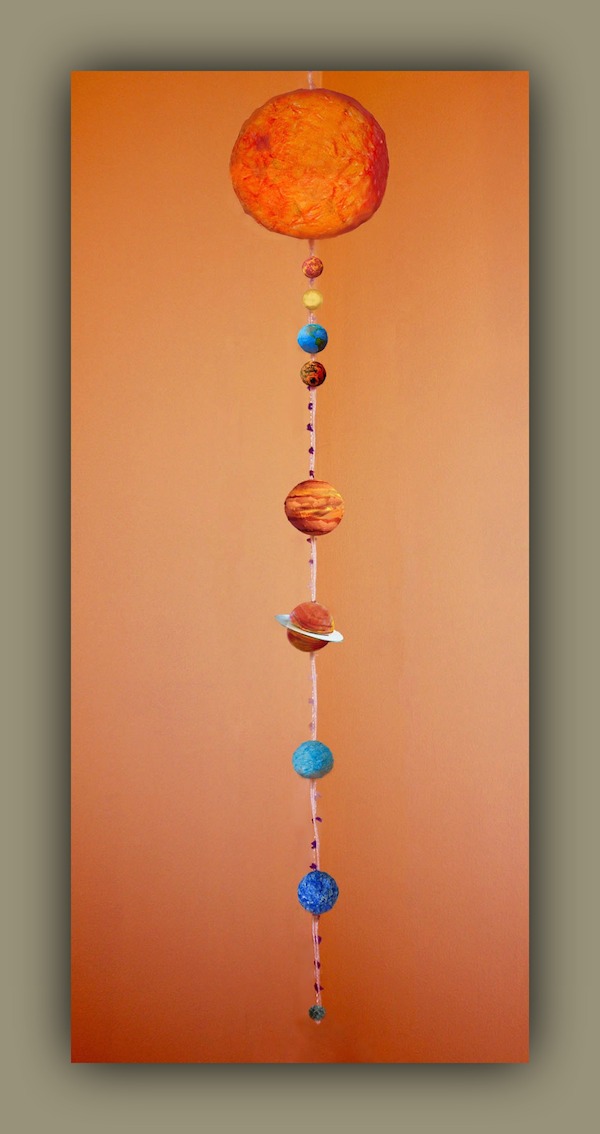Create a Solar System Mobile - AstroCrafts October 2014
- Published: Thursday, October 16 2014 14:37
 Photo by Kathleen Horner
Photo by Kathleen Horner
Our Solar System To be or not to be, that is the question concerning the number of planets in our Solar System. Pluto has taken a beating over the years as it was once considered a planet until the International Astronomical Union came up with a new classification of what defines a 'planet'. The IAU in 2006 re-classified Pluto as a dwarf planet and now today among much controversy has been voted back into planet status by an unofficial vote just recently. But that doesn't mean everyone agrees on this decision and its just a vote so the controversy continues among scientists for now. A new category of dwarf planets have been labeled as trans-Neptunian objects (or asteroids), because they orbit the Sun at a greater distance on average than Neptune. Pluto, Ceres and Eris are now considered to be in this category. We won't know for sure about Pluto's status as a planet vs. a dwarf planet until NASA's New Horizon mission flies by the Pluto system in July 2015. Having been shrouded in mystery since its discovery in 1930, a treasure trove of new information and data will be gathered from Pluto during this great historical mission. Not since 1965 when the Mariner 4 flew past Mars has there been such excitement and anticipation in the exploration of a new planet. Personally, I'm rooting for Pluto to get its planet status back for good.

Credit: International Astronomical Union
To read more in detail about the New Horizons Pluto Mission, click on this link: http://science.nasa.gov/science-news/science-at-nasa/2014/14jan_pluto/
Also, this great link from NASA, discusses our solar system in detail: http://solarsystem.nasa.gov/planets/profile.cfm?Object=SolarSys
Creating your Solar System Mobile
This is a fabulous project for students studying our solar system as well as a grand and unique decor idea. Let's get started:
I used a mix of styrofoam balls and papier-mache balls. The smaller planets are difficult to create from papier-mache as you have to use tiny balloons which makes it challenging to create the balls. Smooth or rough surfaced styrofoam balls are your best bet for the smaller planets.
Materials
Flour
Mixing Bowl
Brushes
Acrylic paint (Variety of colors)
Large and medium size round balloons
Styrofoam balls in all sizes (see below for exact sizes for each planet and Sun)
String
S hook and eye hook (for hanging from ceiling)
Scissors
Ice Pick
Tissue paper, newspaper, recycled paper, etc.
Ribbon (thin), colorful cord, braided yarn cut to 5 feet for mobile streamer
Hot Glue Gun and sticks
CD Disk (for Saturn's rings)
Matte varnish/sealant
How to Make Papier-Mache Sun and Planets
Blow up the large balloon to 9 inches in diameter. Place the balloon into a small round bowl to keep it steady as you work with the papier-mache. Take tissue paper, newspaper, etc. and either cut or tear into strips. Mix flour and water until you get a loose paste-like consistency. Begin your paper mache work by dipping the tissue strips into the paste, removing excess with fingers and placing onto the balloon. Create several layers of the tissue strips keeping it as smooth as possible. Leaving a little opening at the top so you can pop the balloon once its dry. After you have finished, tie a string around the top of the papier-mached balloon and hang to dry. Once dry, paint the surface while the balloon in still inside the ball. After the paint had dried, take a pin and pop the balloon and remove. Painting styrofoam balls makes this project move much faster.
Research online for solar system photos. There is a huge number of wonderful photos online to follow as you paint the surface of each planet ball. You can vary the sizes smaller or larger for the Sun and planet balls. Below is a basic list of sizes to follow:
Sun: - 9 inches
Mercury - 1 1/2 inches
Venus - 1 1/2 inches
Earth - 2 inches
Mars - 1 3/4 inches
Jupiter - 5 inches
Saturn - 4 inches
Uranus - 3 inches
Neptune - 3 inches
Pluto - 1 inch
Lay out on a table the 5 foot streamer in which you will attach the Sun and planets. Any choice of ribbon, colorful cord or yarn will be fine for the streamer. Heat up your hot glue gun. After you have created and dried the Sun and planets, begin by taking an ice pick and poking a hole in the top and running it all the way through the center of each styrofoam ball. If you make a papier mache Sun or planet be sure to leave a very small hole at the top and bottom to run the mobile streamer through. You may need to attach (tape or tie) the mobile streamer to a pencil or stick to run it all the way though each ball to the very bottom. As you run the streamer through each ball, put a tiny bead of hot glue on the top and bottom of each ball to secure it to the streamer.
Of course, this hanging mobile is not to scale, so you have to guess and get creative on spacing each planet. Study the photo of the mobile I created to get a good idea (first photo shown above). Once you have finished your mobile, tie the top part of your mobile streamer onto an S hook and attached it to a eye hook that's been screwed into the ceiling.
Then sit back and enjoy! Makes for a great conversation piece when guests drop by.








Comments